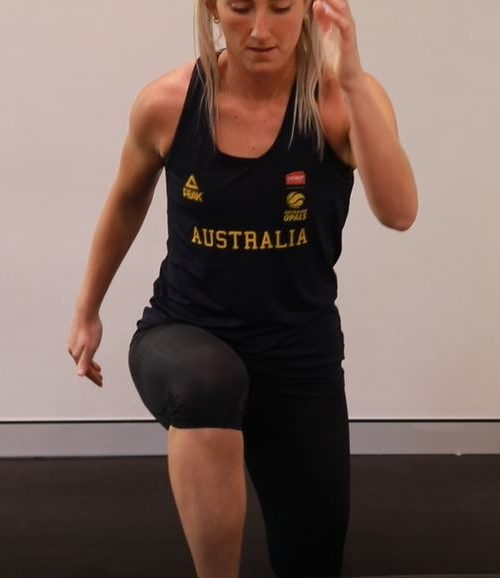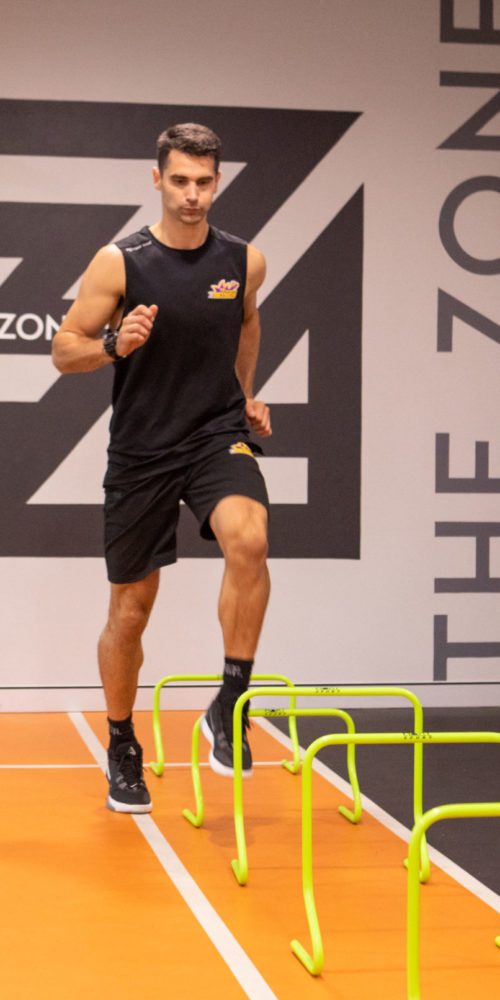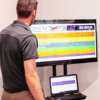Hop tests are just one way to monitor improvement and functional ability following a lower limb injury.
A Limb Symmetry Index (LSI) can be determined by comparing the scores of the injured leg vs the un injured leg [LSI = (Injured leg / Uninjured leg) x 100)].
A recent paper by Davies et al (2020) reported that common hop tests are reliable, and have a relatively low standard measurement error. There is often a learning effect in performing the tests, making it important athletes are given the opportunity to perform at least 3 trials.
Scores of greater than 90% LSI are generally considered a pass. I would strongly recommend aiming for 95-105% LSI and increase the confidence that the athlete is ready to return to play.
SUGGESTED HOP TESTS
Single Hop for Distance
A single linear horizontal hop that involves:
- Strength + Rate of Force Development
- Stability
- Deceleration
PROTOCOL
- Stand on 1 leg, with toes just behind the start line (0cm)
- Fold arms across chest
- Perform 1 hop as far as possible.
- Stick the landing
- Measure the distance (in c.m.) from the start line to the the back of the heel
- Perform minimum of 3 reps (until learning effect plateaus)
Triple Crossover Hop
A continuous (3) horizontal hop test that involves:
- Change in direction
- Plyometric task
- Rate of Force Development
- Reactive Strength Index
- Deceleration (on final landing)
PROTOCOL
- Stand on 1 leg, with toes just behind the start line (0cm). If testing left left, stand on left side of midline. For right leg, stand right side of midline.
- Fold arms across chest
- Perform 3 hops as far as possible, each time crossing a 15cm wide centre line
- Stick the 3rd landing
- Measure the distance (in c.m.) from the start line to the the back of the heel
- Perform minimum of 3 reps (until learning effect plateaus)
Side Hops in 30 sec
A continous horizontal hop tests that involves:
- Repeated Medial/Lateral Change in Direction
- Plyometric task
- Reactive Strength
- Endurance
Male athletes should aim to achieve 55 repetitions, and females should aim to achieve at least 43. Note achieving a 90% LSI can be challenging for healthy athletes.
PROTOCOL
- Have two parallel lines marked on ground 40cm apart
- Fold arms across chest
- Hop side to side over the 40cm markers, as many times as possible in 30 seconds.
- Subtract any attempts that landed on a line, or in between the lines.
- Rest for 2 minutes before testing the other leg
Vertical Hop for Height
A single vertical hop that involves
- Rate of Force Development
- Deceleration (vertical forces)
Vertical hop tests tend to be more sensitive in detecting asymmetries than horizontal hop tests. Vertical hops increase the demands at the knee, making it a challenging test for ACL reconstructions, meniscus and MCL injuries.
PROTOCOL
- Jump Mat or appropriate Force Plates required
- Stand on 1 leg
- Hop as high as possible before landing back on the Jump Mat
- Repeat at least 3 repetitions (or until learning effect has plateaud)
Repeated Vertical Hop over 10 second
Continuous vertical hops assessing:
- Ground Contact time
- Vertical Height
- Reactive Strength Index
The goal is for athletes to have a short contact time on the ground, achieve a good vertical height, and minimise reduction in performance over the 10 seconds.
Up to a third of healthy athletes can not achieve a LSI of 90% . The cut off for this test needs to be individualised.
PROTOCOL
- Jump Mat or appropriate Force Plates required
- Stand on 1 leg
- Continously hop as high as possible on 1 leg for 10 seconds
- Repeat on the other leg
- Perform three trials
Comparing Left vs Right – some potential pitfalls
Using the Limb Symmetry index and comparing left vs right legs on hop tests is convenient, and in the majority of instances an appropriate measure of function.
DETRAINING
For longer term injuries (e.g. ACL reconstruction, stress fractures, high ankle sprain) the time away from activity may lead to a decrease in scores even on the uninjured leg.
In such instances, it would be ideal to have hop test scores from pre injury (from screenings or previous conditions). Alternatively consider testing the uninjured leg soon after injury before the effects of detraining are apparent.
MOTIVATION
Numerous factors may influence the athletes effort during a hop test. Factors that may leed to a submaximal attempt (on either leg) include fear, apprehension of pain or stability, or reduced motivation to perform at maximal effort.
Or consider the athlete who is determined to achieve a pass result on hop tests to be cleared to return to play. By setting a lower target via a submaximal effort on the uninjured leg, they increase the likelihood of achieving > 90% LSI on the injured leg.
This scenario is clearly very unlikely, and from personal experiences athletes value accurate data to make decisions around their health. However it does highlight that return to play decision making should be based on a number of factors, and involve the athlete in shared decision making.
ASSESS MOVEMENT QUALITY
The results from the tests above don’t always tell the whole picture. Don’t forget to assess movement quality to look for:
- Compensatory strategies
- High risk biomechanics
Smart phones and devices can be used to record from side on (sagittal plane) and front on (coronal plane).
Wearable tech is becoming more common, and can be used to help with measuring joint angles, ground reaction forces, and other metrics.
REFERENCES
- Davies, W. et al., It it time we better understood the tests we are using for Return to Sport decision making following ACL reconstruction? A critical review of the hop tests. Sports Medicine, 2020.
If you have had a recent injury please consult a health professional prior to attempting any of these hop tests. A Sports and Exercise Physiotherapist will be able to help diagnose your injury, tailor the rehabilitation and ensure it is safe to introduce more challenging drills.
If you would like a telehealth video consult or detailed return to sport rehabilitation plan please email david@basketball.physio
For more ideas on rehabilitation take a look at the Recover pages
 Return to Play: Hop tests
Return to Play: Hop tests
Return to Play: Hop tests
 Frequency of knee injuries in basketball
Frequency of knee injuries in basketball
Frequency of knee injuries in basketball
 Frequency of Ankle Injuries in Basketball
Frequency of Ankle Injuries in Basketball
Frequency of Ankle Injuries in Basketball
 Lateral ankle sprain
Lateral ankle sprain
Lateral ankle sprain
 Calf strains
Calf strains
Calf strains
 Spanish Squats for patella tendinopathy
Spanish Squats for patella tendinopathy
Spanish Squats for patella tendinopathy
 Concussion
Concussion




